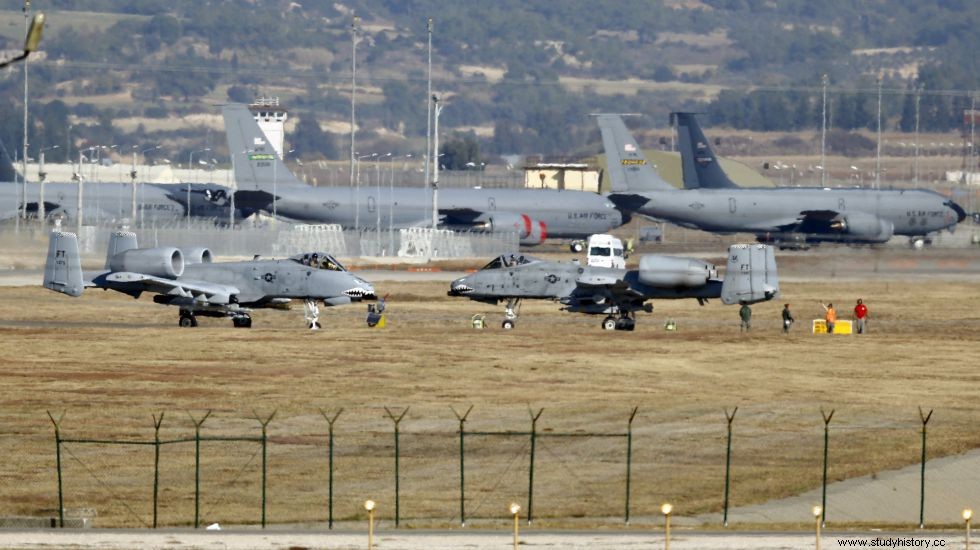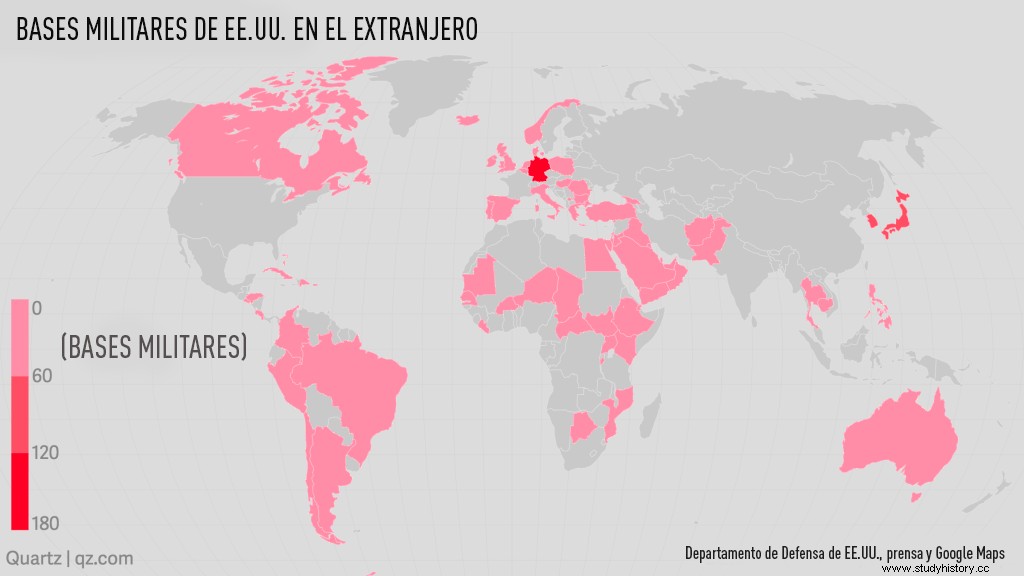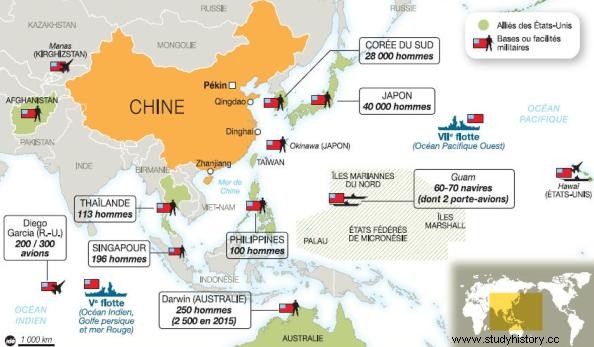The world stopped being bipolar at the end of the Cold War. Then came what has been called multilateralism, that is, the appearance on the geopolitical scene of new actors:China, Russia, India, the EU, etc. This basically meant that Russia was reduced to the status of a regional power and that the United States gave up undertaking major military actions on its own. The wars in Iraq and Afghanistan proved this theory right, strengthened during the Obama presidency. For now, Trump has been more in favor of solitary actions – punctual attack on the Syrian regime of Al Assad; approach of the Pacific fleet to the Korean peninsula,…– but it is still early to clarify the true intentions of the North American president. Despite multilateralism, the United States remains the main military power on the planet and far behind the rest.
The US military bases abroad and the permanent naval fleets distributed throughout the geography of the planet constitute the foundations of the warlike power of the United States. Of these, the primary factor, because it is the one that allows the projection of its force, is that of the bases – land, naval or air – and their geographical distribution.

Many of these bases have their origins in the Cold War era, but others have been created more recently as responses to needs or conflicts arising after the disappearance of the communist bloc. During the "cold" confrontation with the USSR, the United States tried to place military units where communist expansion could constitute a danger. All this infrastructure, however, has been maintained and the US currently has some 800 military bases whose maintenance costs US taxpayers some 100 billion dollars a year; in the same way, a high percentage of its troops are deployed in foreign countries:Japan, Germany, South Korea, Afghanistan, Iraq,... up to 74 countries. The differences with the rest of the powers is overwhelming:France has military bases in 11 countries, Great Britain also in 11 countries, Russia in 9 and China in 1.
Despite the fact that there are several threats to US world leadership, its military potential and, above all, its ability to deploy it anywhere on the planet make the United States the military hegemon. Apart from its enormous spending on defense and the potential of its army, what also differentiates the US from other powers –Russia, China,…– is precisely the availability of bases on all continents, including even Greenland. And this without counting on the secret bases, which are known to exist but not where; They are the so-called water lily bases – small bases that serve as transit or small-scale operations centers. This network of bases is not explained solely by the defensive needs of the United States as a country. Its disposition obeys a policy that seeks to maintain a universal, clear and effective military hegemony. She makes possible the interventionism of the United States in almost all warlike conflicts where their interests require it.

Observing the map of the distribution of these bases, we can deduce where the main US military interest is concentrated. The largest number of bases is concentrated in Europe, the Middle East and the Sea of Japan. Much of America's air power resides in European bases, many of which also belong to NATO. For example, the German base in Ramstein is key in the supply route from the United States to the Middle East or Afghanistan. The C-130, C-17 or C-5 Galaxy transport planes perfectly fulfill this task, essential for keeping the war machine oiled. This base is also key for the control of the drones that monitor the conflict zones of the Middle East or North Africa.
The bases in Europe –the aforementioned Ramstein, Rota (Spain), Morón (Spain), Aviano (Italy),…– are a reminder of the prevailing strategic approaches during the Cold War. However, new bases have emerged in hot areas or that have an interest in order, above all, to control Russia's movements in Eastern Europe. These presuppositions can be applied, for example, to the air bases of Tuzla (Bosnia-Herzegovina), Taszár (Hungary), Graf Ignatievo (Bulgaria) or the land base of Camp Bondsteel in Kosovo. The United States still has nuclear weapons on European soil, especially in Germany. But what strategic interest does Europe currently have for the United States? The answer is threefold:
- Participation in the control of the Arctic through the Nordic countries. This sea is an area of economic interest – gas and oil deposits – and a possible inter-oceanic shipping route if the observed melting trend is confirmed. It is also an area of possible confrontation with Russia.
- The Balkans is a region currently stabilized but with frozen conflicts. Its geographical position is essential for access to the Middle East, a region where the main armed conflicts are currently taking place and where the tensions –Sunnies against Shiites; Israelis against Palestinians; terrorism; unstable countries, etc.–, are on the surface. In addition, the region controls the entrance to the Black Sea as well as the access of the Russian fleet to the Mediterranean.
- Southern Europe provides an essential geographic base for surveillance of North Africa, a region not yet fully stabilized since the convulsions of the Arab springs.
The presence of US bases in Africa is mainly due to the need to collect information on Islamic terrorism and intelligence tasks carried out using drones. These bases have been set up in countries affected by radical jihadism – Mauritania, Senegal, Burkina Faso, etc. – However, its main base in Africa is Camp Lemonnier, a naval station located in Djibouti and from where it can project its force over the entire world. east of the continent.
In Latin America, the Pentagon has created new bases in Chile, Colombia, El Salvador, etc. And it has expanded others that it already had –Honduras, Belize, Costa Rica,…– the presence of bases in the American continent is not due to the prevention of possible armed attacks on the United States but to control of the territory, the maintenance of alliances and access to resources or markets.
The western Pacific zone is becoming a fundamental strategic reference in the interest of the Pentagon. Both China and Russia have access to this region, powers that can challenge North American hegemony and that the United States must contain. Apart from this, there is the permanent conflict with North Korea, whose threat serves to establish the US presence in Japan and South Korea, countries with a huge presence of US troops. The other major goal is to monitor China's maritime expansion; this explains the return of its military presence in the Philippines, the growing rapprochement with Vietnam or the new treaties with Thailand are part of this strategy.
Simultaneously, and in relation to the Pacific region and the control of maritime routes in that area, the North American presence has been consolidated in the Indian Ocean, where the important Diego García base already existed, and where new bases have emerged in African coastal countries. –Kenya, Mozambique,…–, as well as in the area of the Horn of Africa. Here with the confessed objective of combating piracy –the aforementioned base in Djibouti or the presence in Ethiopia– that is projected from Somalia, whose attempt at control became one of its most notorious failures.

Bibliography.
Fontana, J. (2011). For the good of the empire . Barcelona:Past and Present Ed.
Jenkins, P. (2012). Brief history of the United States . Madrid:Publishing Alliance.
Olmo, G.D. (2017). The immense military network with which the United States dominates the world Retrieved from http://www.abc.es/internacional/abci-inmensa-militar-estados-unidos-domina-mundo-201704171957_noticia.html
Drafting. (2017). How big is America's nuclear power and why Donald Trump wants more Retrieved from http://www.bbc.com/mundo/noticias-internacional-39085377
Vine, D. (2012). Water Lilies:America's new bases around the globe Retrieved from http://www.tercerainformacion.es/antigua/spip.php?article40133
